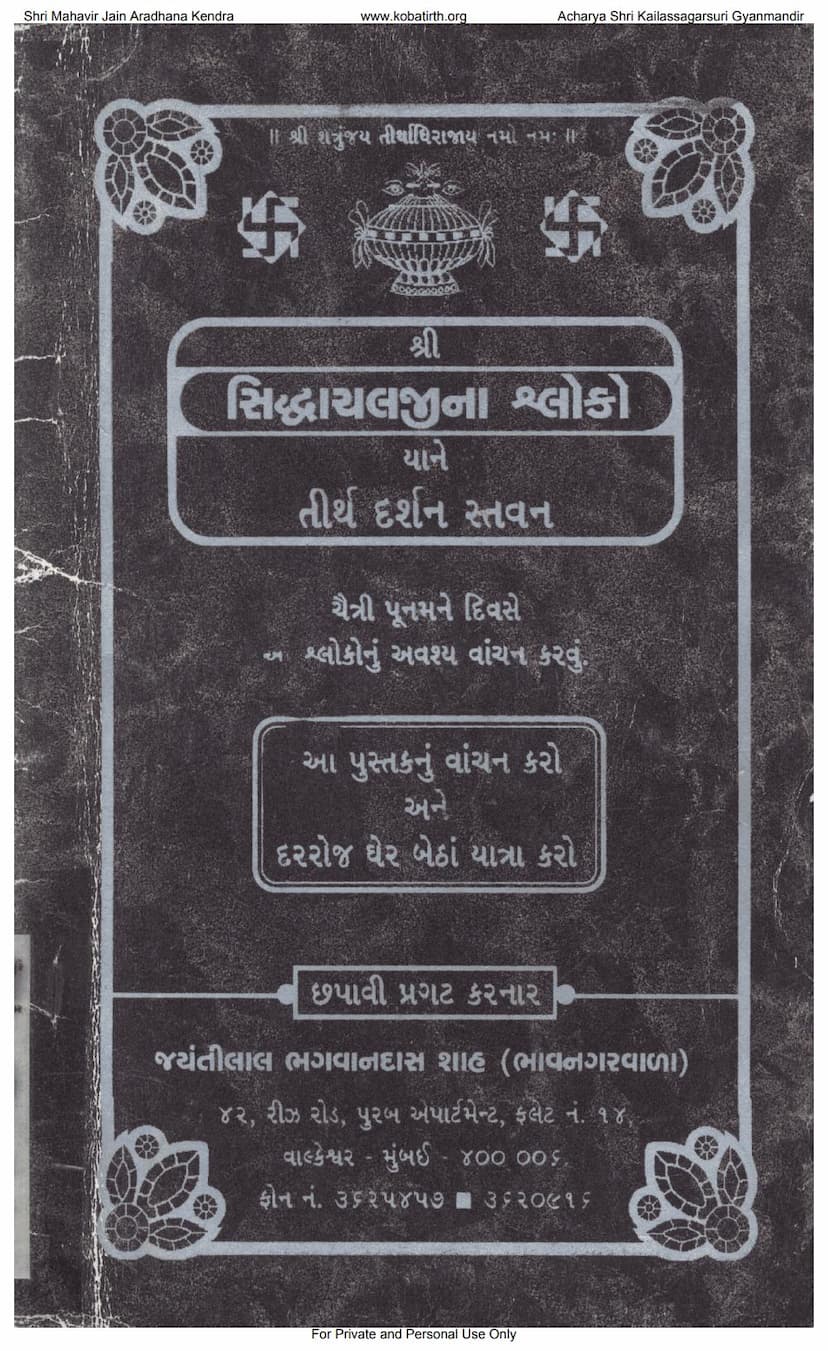Siddhachaljina Shloko Yane Tirth Darshan Stavan
Added to library: September 2, 2025

Summary
Here's a comprehensive summary of the Jain text "Siddhachaljina Shloko Yane Tirth Darshan Stavan" by Jayantilal Bhagwandas Shah, based on the provided pages:
Overall Purpose and Significance:
The book "Siddhachaljina Shloko Yane Tirth Darshan Stavan" is a collection of devotional hymns and verses primarily focused on Siddhachalji (Shatrunjay Tirth), a highly revered pilgrimage site in Jainism. The primary purpose of the book is to allow devotees to experience a virtual pilgrimage of Siddhachalji from their homes. It is recommended to be read on the day of Chaitri Purnima (full moon in the month of Chaitra), but also as a daily practice.
Author and Publisher:
- Author: Jayantilal Bhagwandas Shah (from Bhavnagar). The text also mentions his passing on January 5, 1988, and offers prayers for his soul.
- Publisher: Jayantilal Bhagwandas Shah.
- Associated Institution: Shri Mahavir Jain Aradhana Kendra, www.kobatirth.org, Acharya Shri Kailassagarsuri Gyanmandir.
Key Themes and Content:
-
Devotion to Siddhachalji: The central theme is the profound devotion and reverence for Siddhachalji, the mountain where numerous Jain Tirthankaras and saints have attained liberation (moksha). The verses express a deep longing to visit the sacred site.
-
Virtual Pilgrimage: The book facilitates a "tirtha darshan" (pilgrimage viewing) from home. By reciting these verses, devotees can feel as if they are physically present at Siddhachalji and experiencing its various sacred spots.
-
Praise for Tirthankaras: The verses specifically praise Lord Rishabhdev (Adinath), the first Tirthankara, and other Tirthankaras like Nemnath, Ajitnath, Shantinath, and Parshwanath.
-
Spiritual Aspirations: The hymns express several core Jain spiritual aspirations:
- Overcoming Karma: The verses lament being caught in the cycle of birth and death ("lakh chorashi" - 8.4 million life forms) and being bound by eight types of karma.
- Seeking Liberation: There is a strong desire to escape the ocean of worldly existence (bhavsagar) and attain liberation.
- Attaining Samadhi Maran: The aspiration to die peacefully with spiritual equanimity is expressed.
- Receiving Wisdom: Prayers are offered for wisdom (sumati) to overcome ignorance (kumati).
- Attaining Moksha: A significant desire is to be born in Mahavideh Kshetra (a region where Tirthankaras are still present) and to shed all karma to attain moksha.
- Eternal Devotion: The wish to remain with the Tirthankara in all future lives is a recurring sentiment.
-
Description of Siddhachalji: The verses detail various "tuks" (stops or sacred spots) and structures within Siddhachalji, including:
- The main temples dedicated to Adinath.
- Temples of Parshwanath, Chandraprabhu, and other Tirthankaras.
- Footprints of revered figures like Bharat, Nemnath, Hanuman, Abadbadji, Balabhai, Motisha, Marudevan, Nabhiraja, and Pundarik Ganadhar.
- Specific locations like the Derani Jethani Gokhla, Motisha ni Tuk, Van Vasahi Tuk, and the three circumambulations (bhamti).
- References to other significant Jain pilgrimage sites like Girnar, Ashtapad, Sametshikhar, Pavapuri, Champapuri, and more.
-
The Navkar Mantra: The text prominently features the Navkar Mantra, emphasizing its power to destroy sins and its auspiciousness.
-
Praise for Devi Padmavati: A specific section is dedicated to the Aarti (devotional song) of Goddess Padmavati, the Yakshini (attendant deity) of Parshwanath. It highlights her role as the protector of the Jain faith and her power to grant wishes and alleviate suffering.
-
Guidance on Respect and Practice:
- Respect for the Book: Devotees are cautioned to handle the book with care to avoid any disrespect (ashatana) and to keep it with other religious texts.
- Importance of Life Protection (Jivadaya): A practical instruction is given regarding checking gas stove burners for insects and gently blowing them out, emphasizing the importance of Jivadaya (compassion for all living beings).
-
Family Context: The book mentions Jayantilal Bhagwandas Shah's family, including his wife Vasantben, sons Ajitbhai, Hareshbhai, Nareshbhai, Mukeshbhai, and daughters Minakshiben and Kunjalben, highlighting the good sanskaras he imparted. Vasantben is also described as having received religious upbringing from her parents who had taken diksha (renunciation).
-
Praise for the Translator/Publisher: The text acknowledges the efforts of previous individuals who helped in printing and publishing the work, including Shri Gunvantiben Mohunlal Kothari.
In essence, "Siddhachaljina Shloko Yane Tirth Darshan Stavan" serves as a spiritual guide and devotional companion for Jains, enabling them to connect with the sacredness of Siddhachalji and the teachings of the Tirthankaras through recitation and contemplation, fostering devotion, spiritual aspiration, and compassion.